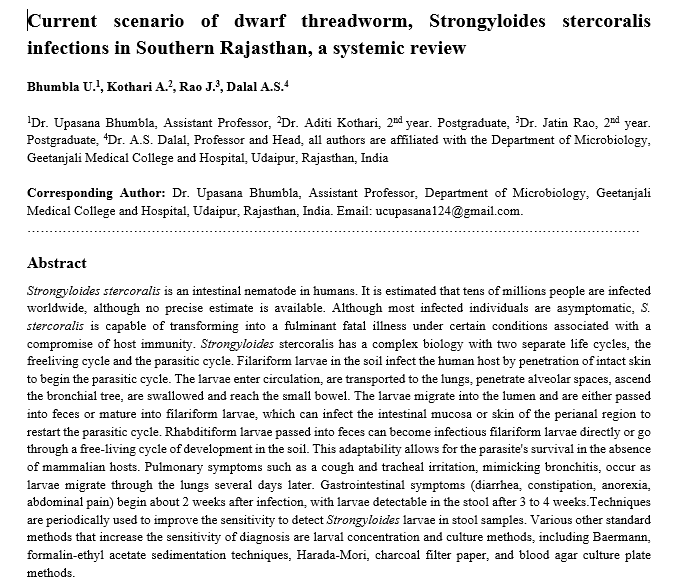Current scenario of dwarf threadworm, Strongyloides stercoralis infections in Southern Rajasthan, a systemic review
Abstract
Strongyloides stercoralis is an intestinal nematode in humans. It is estimated that tens of millions people are infected worldwide, although no precise estimate is available. Although most infected individuals are asymptomatic, S. stercoralis is capable of transforming into a fulminant fatal illness under certain conditions associated with a compromise of host immunity. Strongyloides stercoralis has a complex biology with two separate life cycles, the freeliving cycle and the parasitic cycle. Filariform larvae in the soil infect the human host by penetration of intact skin to begin the parasitic cycle.
Downloads
References
Gupta N, Choudhary A, Mirdha B R, Kale P, Kant K, Ghosh A. Strongyloides stercoralis Infection: A Case Series from a Tertiary Care Center in India. J Glob Infect Dis. 2017;9(2):86-87. doi: https://doi.org/10.4103/0974-777X.204694.
Arora DR, Arora BB. Textbook of Medical Parasitology CBS Publishers, 3rd Edition 2013. Isosporabelli; Chapter 5;97-99.
Tripathi KD. Essentials of medical pharmacology, JP Medical Ltd; 6th edition; pp 764.
Arakaki T, Iwanaga M, Kinjo F, Saito A, Asato R, Ikeshiro T. Efficacy of agar plate culture in detection of strongyloidesstercoralis infection. J Parasitol. 1990;76(3):425-428.
Parija SC. Textbook of medical parasitology, 3rd edition 2006, pp. 294-300.
Bhumbla U. Strongyloidiasis in seronegative patient: A case report. Med Sci. 2014;6(22):94-96.
Varatharajalu R, Kakuturu R. Strongyloides stercoralis: current perspectives. Dovepress. 2016;5:23-33. doi: https://doi.org/10.2147/RIP.S75839.
Jourdan PM, Lamberton PHL, Fenwick A, Addis DG. Soil-transmitted helminth infections. Lancet. 2017;391(10117):252-265. doi: https://doi.org/10.1016/S0140-6736(17)31930-X.
Hailemariam G, Kassu A, Abebe G, Abate E, Damte D, Mekonnen E, et al. Intestinal parasitic infections in HIV/AIDS and HIV seronegative individuals in a teaching hospital, Ethiopia. Jpn J Infect Dis. 2004;57(2):41-43
Ghoshal UC, Alexender G, Ghoshal U, Tripathi S, Krishnani N. Strongyloides stercoralis infestation in a patient with severe ulcerative colitis. Indian J Med Sci. 2006;60(3):106-110. doi: https://doi.org/10.4103/0019-5359.22761.
Blatt JM, Cantos GA. Evaluation of techniques for the diagnosis of Strongyloides stercoralis in human immunodeficiency virus (HIV) positive and HIV negative individuals in the city of Itajai, Brazil. Brazil J Infect Dis. 2003;7(6):402-408. doi: http://dx.doi.org/10.1590/S1413-86702003000600008.

Copyright (c) 2020 Author (s). Published by Siddharth Health Research and Social Welfare Society

This work is licensed under a Creative Commons Attribution 4.0 International License.


 OAI - Open Archives Initiative
OAI - Open Archives Initiative


